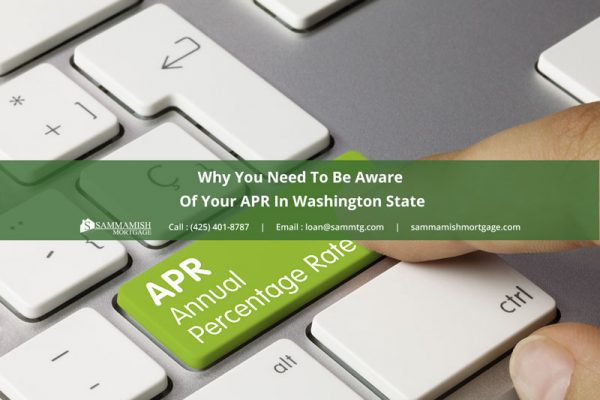No Obligation and transparency 24/7. Instantly compare live rates and costs from our network of lenders across the country. Real-time accurate rates and closing costs for a variety of loan programs custom to your specific situation.

Why do you need to be aware of your APR in Washington State? Initially, it will be the best way for you to compare mortgage loan offers from different lenders. Understanding your APR will give you a clearer idea of how much your overall mortgage will actually cost you at the end of the day and will help you find the best deal. This article will go over APRs and why they’re important for homebuyers to understand.
You may have heard the term “APR,” but do you know what it means? When shopping for a home in Washington State, the APR may be the most important term you need to understand. There are many reasons for this, the most important of which comes down to dollars and cents. To put it more directly, understanding your APR could save you a lot of money.
What exactly is your APR? An acronym for Annual Percentage Rate, APR is the amount you pay annually to borrow money for your home purchase. It is usually expressed as a percentage of the total loan amount. The question is, what’s the difference between APR and your interest rate?
You need to be aware of your APR when purchasing a home in Washington State. When shopping for mortgage options, you will need to consider more than just the interest rate alone without factoring in any other costs. It’s impossible to get an accurate idea of the actual cost for caparison without an accurate APR.
There are lots of different mortgage products available today. Banks and mortgage companies are in the business of lending, and the more varied products they can provide, the more customers they can appeal to. When shopping for a mortgage, be sure to pay attention to the total cost of the loan so you can compare apples to apples.
In some cases, a lower APR doesn’t necessarily mean a cheaper loan. APR is calculated over the life of the loan, so it assumes you will carry the loan for the full term (usually expressed as a 30-year period). If you plan to pay your mortgage off early, the total cost including fees will not be spread over the 30-year term, but instead over the term of ownership. This will result in a much higher APR.
There are other instances that can be just as deceiving. Advertised APR may fail to include things like private mortgage insurance costs. If you are planning to contribute less than 20% of the home’s value as a down payment, you will need to secure mortgage insurance, which would have a direct effect on your monthly payment.
APR is used to express the true cost of borrowing money. Let’s take a look at some of the most common costs you should expect to see included with your APR.
Mortgage points, or “Discount Points,” are the fees you pay your lender upfront to reduce the interest rate (this is also known as “buying down the rate”). Generally speaking, 1 point is equal to 1% of the total mortgage amount.
Prepaid Interest is charged by the lender and reflects the amount of interest that accrues between the closing of the property and your first mortgage payment. For example, if you close on the 5th of June, you would pay 25 days of “prepaid” interest.
Also known as a loan origination fee, this is the charge your lender assesses for preparing and evaluating your mortgage. Administration fees can include notary services and charges from the lender’s attorney, as well as any fees for document preparation. Usually, administration fees amount to no more than 0.5% of the total amount you’re borrowing.
The processing fee is usually around $200 and includes all costs associated with processing your mortgage application.
Underwriters work in a variety of markets in addition to mortgages, including investments and insurance. When it comes to mortgages, underwriters are responsible for evaluating and verifying mortgage applications. This fee covers the cost of those underwriting activities.
Because it takes time and money to prepare your loan estimate, lenders typically charge between $50 and $100 to cover the costs of preparation.
Private mortgage insurance (PMI) is insurance you may be required to pay to secure a conventional loan if you are putting up less than 20% of the home’s value as a down payment.
This fee covers the service charges for the Escrow officer that assists with your closing.
After all those costs, there are still many fees that may be excluded from the APR. Remember: just because they don’t show up as part of your APR does not mean you don’t have to pay them. They may include:
When you purchase a property, a document search is conducted to ensure a clean chain of title. To put it in simpler terms, a title search is conducted to make sure that the person selling actually has the legal right to do so. The title fees cover that process as well as insurance to make sure there are no mistakes.
While Washington state does not require you to have an attorney present at your closing, it may be a good idea. Real estate attorneys typically charge less than $500 to facilitate a real estate transaction on your behalf. These attorneys have seen lots of closings, understand the documents, and can provide an extra layer of protection for you during the purchasing process.
A notary is an individual licensed by the state to apply a seal to documents signifying an official witness to any signatures. Generally, it is accrued per signature, but can vary.
Sometimes a closing agent will asses a document preparation fee. This is separate from the fee charged by your lender and it covers the preparation of all documents related to the closing, which there may be many of.
While it’s not generally required in Washington State, a home inspection is one of the cheapest “insurance policies” you can buy as a new homeowner. Licensed professional home inspectors usually charge somewhere between $250 and $500 for an in-depth inspection and report of the property. They check for all kinds of things, from the foundation to the roof, and pretty much everything in between. A home inspection may not be required, but it’s the easiest way to get a good idea of what you are buying.
Recording fees are the amount generally charged by a government agency to register real estate purchases with the county so it becomes part of the public record.
Real estate transfer taxes are assessed by states, counties or municipalities for transferring real property within that territory.
Your lender may charge you a fee to pull your credit report. Get a Free Credit Report Now.
Independent professional licensed appraisers are employed by the lender to asses the real value of the property so underwriters can ensure the real estate is worth the amount of the loan.
There are a lot of costs and fees associated with buying a home and it may be a little confusing to understand your APR. In 1968, the Truth In Lending Act was established to promote the informed use of consumer credit. Rather than regulating what kinds of fees can be associated with loaning money, the larger goal of the Truth In Lending Act is to require consistent and thorough disclosure of all costs.
As of October 3, 2015, a form called the Loan Estimate replaced the initial Truth-in-Lending disclosure for most home mortgages. A Closing Disclosure replaced the final Truth-in-Lending disclosure.
The Truth In Lending Act requires APR to be disclosed as a single rate for mortgage loans. The last page of the document has a “Comparisons” section that shows you how much money you will pay towards your mortgage in five years, including the amount of principal that will be paid off.
According to the Truth in Lending Act, your mortgage lender is required to provide you with a Loan Disclosure during the home purchase process. is a three-page document that your lender is required to give you after you apply for a mortgage. This document details important information about the mortgage you are applying for, including the estimated interest rate, your monthly payment amount, and the total closing costs for your mortgage. It is important to review those numbers carefully.
Whether you are looking to buy, refinance, or just have questions about homeownership, visit with your trusted home mortgage expert at Sammamish Mortgage today. Let our team of professionals guide you through the process. Family-owned and operated since 1992, we offer a variety of loan programs in Washington State, Oregon, Idaho, and Colorado. Please contact one of our friendly staff members today. We look forward to serving you.


Whether you’re buying a home or ready to refinance, our professionals can help.
{hours_open} - {hours_closed} Pacific
No Obligation and transparency 24/7. Instantly compare live rates and costs from our network of lenders across the country. Real-time accurate rates and closing costs for a variety of loan programs custom to your specific situation.